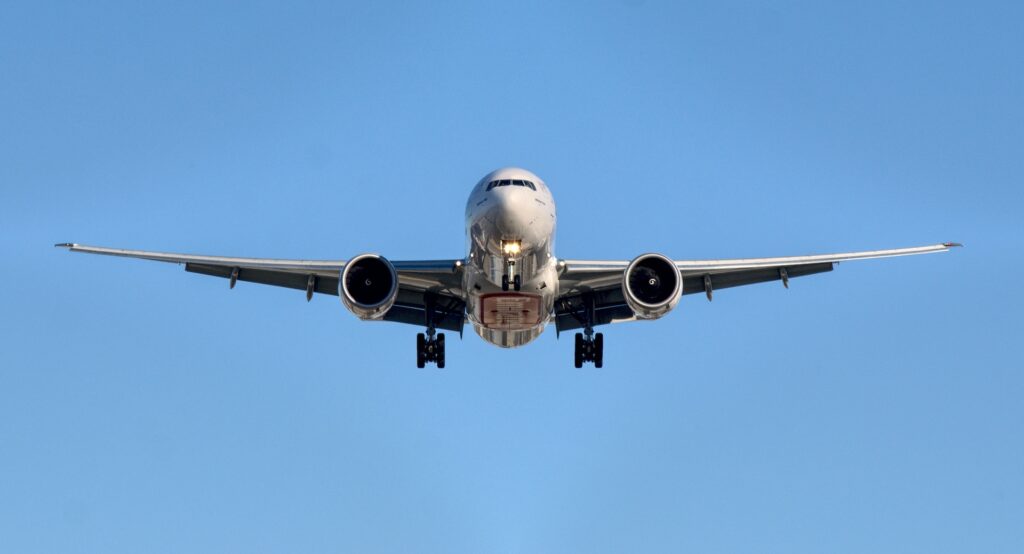The increase, which has long been suspected, is consistent with warmer air temperatures. Skies are predicted to get bumpier as climate change progresses
8 June 2023

Hazardous clear-air turbulence has increased 55% since 1979, according to a new study in Geophysical Research Letters. As climate change progresses, such turbulence will likely continue to increase. Credit: Unsplash
AGU press contact:
Rebecca Dzombak, [email protected] (UTC-4 hours)
University of Reading press contact:
Ollie Sirrell, [email protected] (UTC+1 hour)
WASHINGTON — For aircraft, the skies are up to 55% bumpier today than four decades ago, scientists have found. The new study shows that dangerous clear-air turbulence has increased as the climate has changed.
At a typical point over the North Atlantic, one of the world’s busiest flight routes, the total annual duration of severe turbulence increased by 55% from 1979 to 2020, the researchers found.
“Turbulence makes flights bumpy and can occasionally be dangerous,” said Mark Prosser, a meteorologist at the University of Reading who led the study. “Airlines will need to start thinking about how they will manage the increased turbulence, as it costs the industry $150 to $500 million annually in the United States alone. Every additional minute spent traveling through turbulence increases wear-and-tear on the aircraft, as well as the risk of injuries to passengers and flight attendants.”
The study was published in Geophysical Research Letters, AGU’s journal for high-impact, short-format research with implications spanning the Earth and space sciences.
Clear-air turbulence can be particularly hazardous because unlike turbulence associated with a storm, it’s essentially invisible to remote sensing tools used for aviation. It’s also challenging to predict because it is created by small-scale eddies that are too localized for most weather models to explicitly calculate.
Scientists have evidence that clear-air turbulence will be more frequent in the future because of climate change, but previous efforts to calculate past turbulence trends have been hampered by outdated, low-resolution datasets, non-global coverage, or the use of only a handful of turbulence calculation methods.
To test whether turbulence has increased over time, Prosser and colleagues analyzed 40 years of high-quality atmospheric data. The team went beyond previous work by calculating clear-air turbulence in 21 different ways over the past 40 years for the first time, producing the most detailed picture yet of how turbulence has already started to change.
The researchers found severe clear-air turbulence increased from 17.7 hours in 1979 to 27.4 hours in 2020, or 55%, for an average point over the North Atlantic. Moderate turbulence there increased by 37% from 70.0 to 96.1 hours, and light turbulence increased by 17% from 466.5 to 546.8 hours.
While the North Atlantic experienced the largest increases, the new study found that other busy flight routes over the United States, Europe, the Middle East and the South Atlantic also saw significant increases in turbulence.
The increases in turbulence are consistent with the effects of climate change, according to previous research. Warmer air as a result of carbon dioxide emissions is increasing windshear in the jet streams, strengthening clear-air turbulence in the North Atlantic and globally.
“Following a decade of research showing that climate change will increase clear-air turbulence in the future, we now have evidence suggesting that the increase has already begun,” said Paul Williams, an atmospheric scientist at the University of Reading who co-authored the study. “We should be investing in improved turbulence forecasting and detection systems to prevent the rougher air from translating into bumpier flights in the coming decades.”
#
Released jointly with the University of Reading.
###
AGU (www.agu.org) is a global community supporting more than half a million advocates and professionals in Earth and space sciences. Through broad and inclusive partnerships, AGU aims to advance discovery and solution science that accelerate knowledge and create solutions that are ethical, unbiased and respectful of communities and their values. Our programs include serving as a scholarly publisher, convening virtual and in-person events and providing career support. We live our values in everything we do, such as our net zero energy renovated building in Washington, D.C. and our Ethics and Equity Center, which fosters a diverse and inclusive geoscience community to ensure responsible conduct.
Notes for journalists:
This study is published in Geophysical Research Letters, a fully open-access journal. View and download a pdf of the study here.
Journalists should contact Ollie Sirrell for interview requests.
Paper title:
“Evidence for large increases in clear-air turbulence over the past four decades”
Authors:
- Mark Prosser (corresponding author), Paul D. Williams, R. Giles Harrison, Department of Meteorology, University of Reading, Reading, UK
- Graeme J. Marlton, The UK Meteorological Office, Exeter, UK